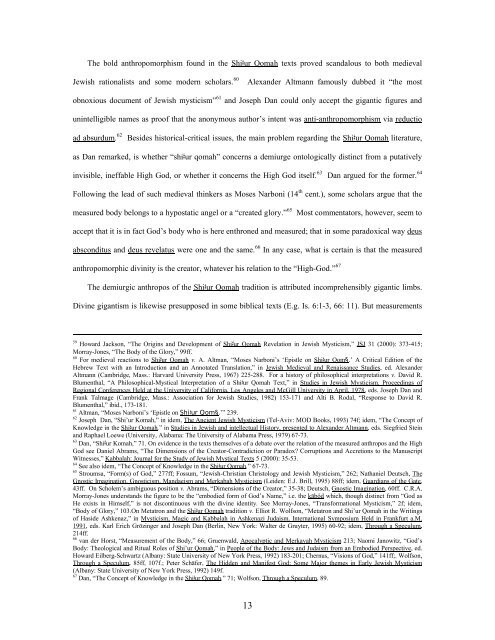Sapphiric God: - Dr. Wesley Muhammad
Sapphiric God: - Dr. Wesley Muhammad
Sapphiric God: - Dr. Wesley Muhammad
Create successful ePaper yourself
Turn your PDF publications into a flip-book with our unique Google optimized e-Paper software.
The bold anthropomorphism found in the Shi#ur Qomah texts proved scandalous to both medieval<br />
Jewish rationalists and some modern scholars. 60 Alexander Altmann famously dubbed it “the most<br />
obnoxious document of Jewish mysticism” 61 and Joseph Dan could only accept the gigantic figures and<br />
unintelligible names as proof that the anonymous author’s intent was anti-anthropomorphism via reductio<br />
ad absurdum. 62 Besides historical-critical issues, the main problem regarding the Shi#ur Qomah literature,<br />
as Dan remarked, is whether “shi#ur qomah” concerns a demiurge ontologically distinct from a putatively<br />
invisible, ineffable High <strong>God</strong>, or whether it concerns the High <strong>God</strong> itself. 63 Dan argued for the former. 64<br />
Following the lead of such medieval thinkers as Moses Narboni (14 th cent.), some scholars argue that the<br />
measured body belongs to a hypostatic angel or a “created glory.” 65 Most commentators, however, seem to<br />
accept that it is in fact <strong>God</strong>’s body who is here enthroned and measured; that in some paradoxical way deus<br />
absconditus and deus revelatus were one and the same. 66 In any case, what is certain is that the measured<br />
anthropomorphic divinity is the creator, whatever his relation to the “High-<strong>God</strong>.” 67<br />
The demiurgic anthropos of the Shi#ur Qomah tradition is attributed incomprehensibly gigantic limbs.<br />
Divine gigantism is likewise presupposed in some biblical texts (E.g. Is. 6:1-3, 66: 11). But measurements<br />
59<br />
Howard Jackson, “The Origins and Development of Shi#ur Qomah Revelation in Jewish Mysticism,” JSJ 31 (2000): 373-415;<br />
Morray-Jones, “The Body of the Glory,” 99ff.<br />
60<br />
For medieval reactions to Shi#ur Qomah v. A. Altman, “Moses Narboni’s ‘Epistle on Shi#ur Qom§.’ A Critical Edition of the<br />
Hebrew Text with an Introduction and an Annotated Translation,” in Jewish Medieval and Renaissance Studies, ed. Alexander<br />
Altmann (Cambridge, Mass.: Harvard University Press, 1967) 225-288. For a history of philosophical interpretations v. David R.<br />
Blumenthal, “A Philosophical-Mystical Interpretation of a Shi#ur Qomah Text,” in Studies in Jewish Mysticism. Proceedings of<br />
Regional Conferences Held at the University of California, Los Angeles and McGill University in April, 1978, eds. Joseph Dan and<br />
Frank Talmage (Cambridge, Mass.: Association for Jewish Studies, 1982) 153-171 and Alti B. Rodal, “Response to David R.<br />
Blumenthal,” ibid., 173-181.<br />
61<br />
Altman, “Moses Narboni’s ‘Epistle on Shi#ur Qom§.’” 239.<br />
62<br />
Joseph Dan, “Shi’ur Komah,” in idem, The Ancient Jewish Mysticism (Tel-Aviv: MOD Books, 1993) 74f; idem, “The Concept of<br />
Knowledge in the Shi#ur Qomah,” in Studies in Jewish and intellectual History, presented to Alexander Altmann, eds. Siegfried Stein<br />
and Raphael Loewe (University, Alabama: The University of Alabama Press, 1979) 67-73.<br />
63<br />
Dan, “Shi#ur Komah,” 71. On evidence in the texts themselves of a debate over the relation of the measured anthropos and the High<br />
<strong>God</strong> see Daniel Abrams, “The Dimensions of the Creator-Contradiction or Paradox? Corruptions and Accretions to the Manuscript<br />
Witnesses,” Kabbalah: Journal for the Study of Jewish Mystical Texts 5 (2000): 35-53.<br />
64<br />
See also idem, “The Concept of Knowledge in the Shi#ur Qomah,” 67-73.<br />
65<br />
Stroumsa, “Form(s) of <strong>God</strong>,” 277ff; Fossum, “Jewish-Christian Christology and Jewish Mysticism,” 262; Nathaniel Deutsch, The<br />
Gnostic Imagination. Gnosticism, Mandaeism and Merkabah Mysticism (Leiden: E.J. Brill, 1995) 88ff; idem, Guardians of the Gate,<br />
43ff. On Scholem’s ambiguous position v. Abrams, “Dimensions of the Creator,” 35-38; Deutsch, Gnostic Imagination, 60ff. C.R.A.<br />
Morray-Jones understands the figure to be the “embodied form of <strong>God</strong>’s Name,” i.e. the kābôd which, though distinct from “<strong>God</strong> as<br />
He exists in Himself,” is not discontinuous with the divine identity. See Morray-Jones, “Transformational Mysticism,” 2f; idem,<br />
“Body of Glory,” 103.On Metatron and the Shi#ur Qomah tradition v. Elliot R. Wolfson, “Metatron and Shi’ur Qomah in the Writings<br />
of Haside Ashkenaz,” in Mysticism, Magic and Kabbalah in Ashkenazi Judaism. International Symposium Held in Frankfurt a.M.<br />
1991, eds. Karl Erich Grözinger and Joseph Dan (Berlin, New York: Walter de Gruyter, 1995) 60-92; idem, Through a Speculum,<br />
214ff.<br />
66<br />
van der Horst, “Measurement of the Body,” 66; Gruenwald, Apocalyptic and Merkavah Mysticism 213; Naomi Janowitz, “<strong>God</strong>’s<br />
Body: Theological and Ritual Roles of Shi’ur Qomah,” in People of the Body: Jews and Judaism from an Embodied Perspective, ed.<br />
Howard Eilberg-Schwartz (Albany: State University of New York Press, 1992) 183-201; Chernus, “Visions of <strong>God</strong>,” 141ff;. Wolfson,<br />
Through a Speculum, 85ff, 107f.; Peter Schäfer, The Hidden and Manifest <strong>God</strong>: Some Major themes in Early Jewish Mysticism<br />
(Albany: State University of New York Press, 1992) 149f.<br />
67<br />
Dan, “The Concept of Knowledge in the Shi#ur Qomah,” 71; Wolfson, Through a Speculum, 89.<br />
13
















